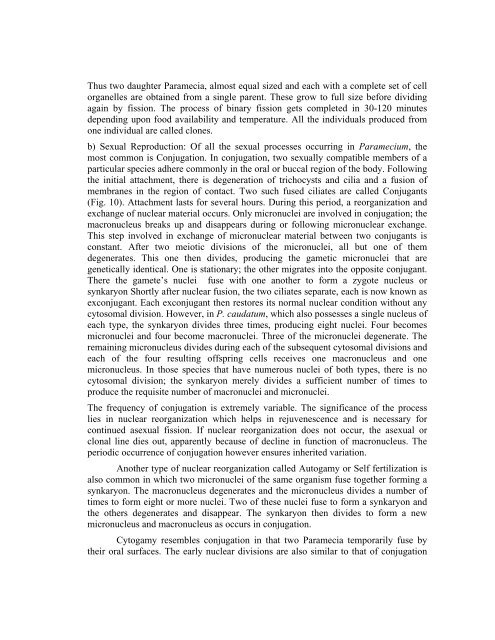ANIMAL DIVERSITY – I (NON-CHORDATES)
ANIMAL DIVERSITY – I (NON-CHORDATES)
ANIMAL DIVERSITY – I (NON-CHORDATES)
You also want an ePaper? Increase the reach of your titles
YUMPU automatically turns print PDFs into web optimized ePapers that Google loves.
Thus two daughter Paramecia, almost equal sized and each with a complete set of cell<br />
organelles are obtained from a single parent. These grow to full size before dividing<br />
again by fission. The process of binary fission gets completed in 30-120 minutes<br />
depending upon food availability and temperature. All the individuals produced from<br />
one individual are called clones.<br />
b) Sexual Reproduction: Of all the sexual processes occurring in Paramecium, the<br />
most common is Conjugation. In conjugation, two sexually compatible members of a<br />
particular species adhere commonly in the oral or buccal region of the body. Following<br />
the initial attachment, there is degeneration of trichocysts and cilia and a fusion of<br />
membranes in the region of contact. Two such fused ciliates are called Conjugants<br />
(Fig. 10). Attachment lasts for several hours. During this period, a reorganization and<br />
exchange of nuclear material occurs. Only micronuclei are involved in conjugation; the<br />
macronucleus breaks up and disappears during or following micronuclear exchange.<br />
This step involved in exchange of micronuclear material between two conjugants is<br />
constant. After two meiotic divisions of the micronuclei, all but one of them<br />
degenerates. This one then divides, producing the gametic micronuclei that are<br />
genetically identical. One is stationary; the other migrates into the opposite conjugant.<br />
There the gamete’s nuclei fuse with one another to form a zygote nucleus or<br />
synkaryon Shortly after nuclear fusion, the two ciliates separate, each is now known as<br />
exconjugant. Each exconjugant then restores its normal nuclear condition without any<br />
cytosomal division. However, in P. caudatum, which also possesses a single nucleus of<br />
each type, the synkaryon divides three times, producing eight nuclei. Four becomes<br />
micronuclei and four become macronuclei. Three of the micronuclei degenerate. The<br />
remaining micronucleus divides during each of the subsequent cytosomal divisions and<br />
each of the four resulting offspring cells receives one macronucleus and one<br />
micronucleus. In those species that have numerous nuclei of both types, there is no<br />
cytosomal division; the synkaryon merely divides a sufficient number of times to<br />
produce the requisite number of macronuclei and micronuclei.<br />
The frequency of conjugation is extremely variable. The significance of the process<br />
lies in nuclear reorganization which helps in rejuvenescence and is necessary for<br />
continued asexual fission. If nuclear reorganization does not occur, the asexual or<br />
clonal line dies out, apparently because of decline in function of macronucleus. The<br />
periodic occurrence of conjugation however ensures inherited variation.<br />
Another type of nuclear reorganization called Autogamy or Self fertilization is<br />
also common in which two micronuclei of the same organism fuse together forming a<br />
synkaryon. The macronucleus degenerates and the micronucleus divides a number of<br />
times to form eight or more nuclei. Two of these nuclei fuse to form a synkaryon and<br />
the others degenerates and disappear. The synkaryon then divides to form a new<br />
micronucleus and macronucleus as occurs in conjugation.<br />
Cytogamy resembles conjugation in that two Paramecia temporarily fuse by<br />
their oral surfaces. The early nuclear divisions are also similar to that of conjugation
















